Winter transforms the landscape into a pristine canvas, and for the observant nature enthusiast, this snowy blanket becomes a storybook written in tracks. While the idea of “Cat Tracks Snow” might first bring to mind domestic felines venturing out, it opens a window into the wider world of wildlife tracking in winter. Understanding animal tracks in snow is a rewarding skill that connects us to the often-unseen lives of creatures around us. Let’s delve into the fascinating world of winter tracking, using the tracks of one intriguing forest dweller – the fisher – as a perfect example.
The fisher (Pekania pennanti) is a captivating animal to follow in the snow. These members of the weasel family, though not felines, leave behind distinctive paw prints that tell tales of their forest journeys. Fishers are active predators, and their tracks reveal a dynamic life as they navigate their snowy domain. They move with purpose, weaving through trees, marking their territory, and hunting for prey. Following a fisher’s trail can reveal a microcosm of the winter forest, showcasing the dramas of predator and prey playing out in the snow. Learning to identify fisher tracks is a fantastic starting point for anyone interested in becoming a winter wildlife tracker.
Many people are surprised by the size of a fisher when they finally see one. Despite their slender bodies, long tails, and relatively short legs, fishers are often mistaken for much larger animals. Weighing only between 5 and 12 pounds on average, these medium-sized mustelids can be easily overestimated. It’s common to hear guesses of 20, or even 50 pounds! This misjudgment likely stems from their thick, fluffy winter coats and long tails, coupled with a natural human tendency to exaggerate the size of wild animals, especially predators. This tendency to overestimate size might even be an evolutionary advantage – it’s safer to overestimate danger in the wild than to underestimate it.
Identifying Fisher Tracks and Signs in Snow
Fisher Track Characteristics
Fisher tracks, like those of many animals, have unique features that aid in identification. The front tracks of a fisher typically range from 2 1/4 to 4 inches wide. A key characteristic is the presence of five clawed toes. The innermost toe, toe number one, is small and set back, often not registering in the snow. However, the other four toes usually leave clear prints. The metacarpal pad, a C-shaped structure (actually fused pads), is typically visible. A smaller carpal pad may also appear as a dot. Crucially, the fisher’s paws are quite furry, which creates “negative space” within the track. This means you often won’t see a continuous connection between the toe tips and the metacarpal pad. However, depending on the snow conditions, hints of these connections might be visible.
Hind tracks are slightly smaller, measuring about 2 to 3 inches in width. The anatomy of the hind feet mirrors the front feet, with the exception of the carpal pad being covered in fur. As a result, the “heel” area of the hind track often registers, but a distinct heel pad impression does not.
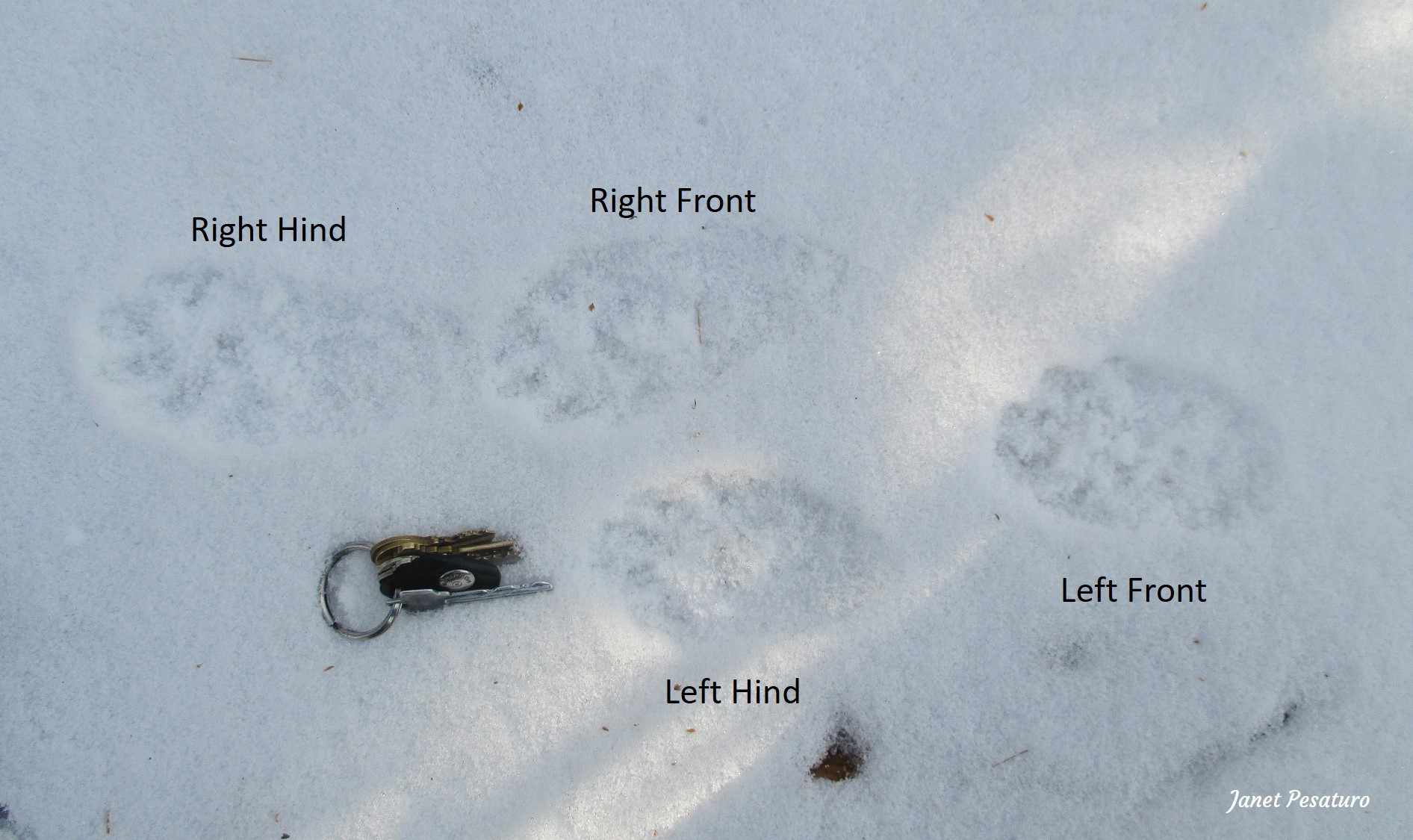 Fisher tracks in a lope pattern in the snow. The pads appear relatively indistinct due to the fisher's furry feet and dry, powdery snow.
Fisher tracks in a lope pattern in the snow. The pads appear relatively indistinct due to the fisher's furry feet and dry, powdery snow.
Fisher tracks in a lope pattern. The indistinct pads are due to the fisher’s furry feet and the dry, powdery snow conditions.
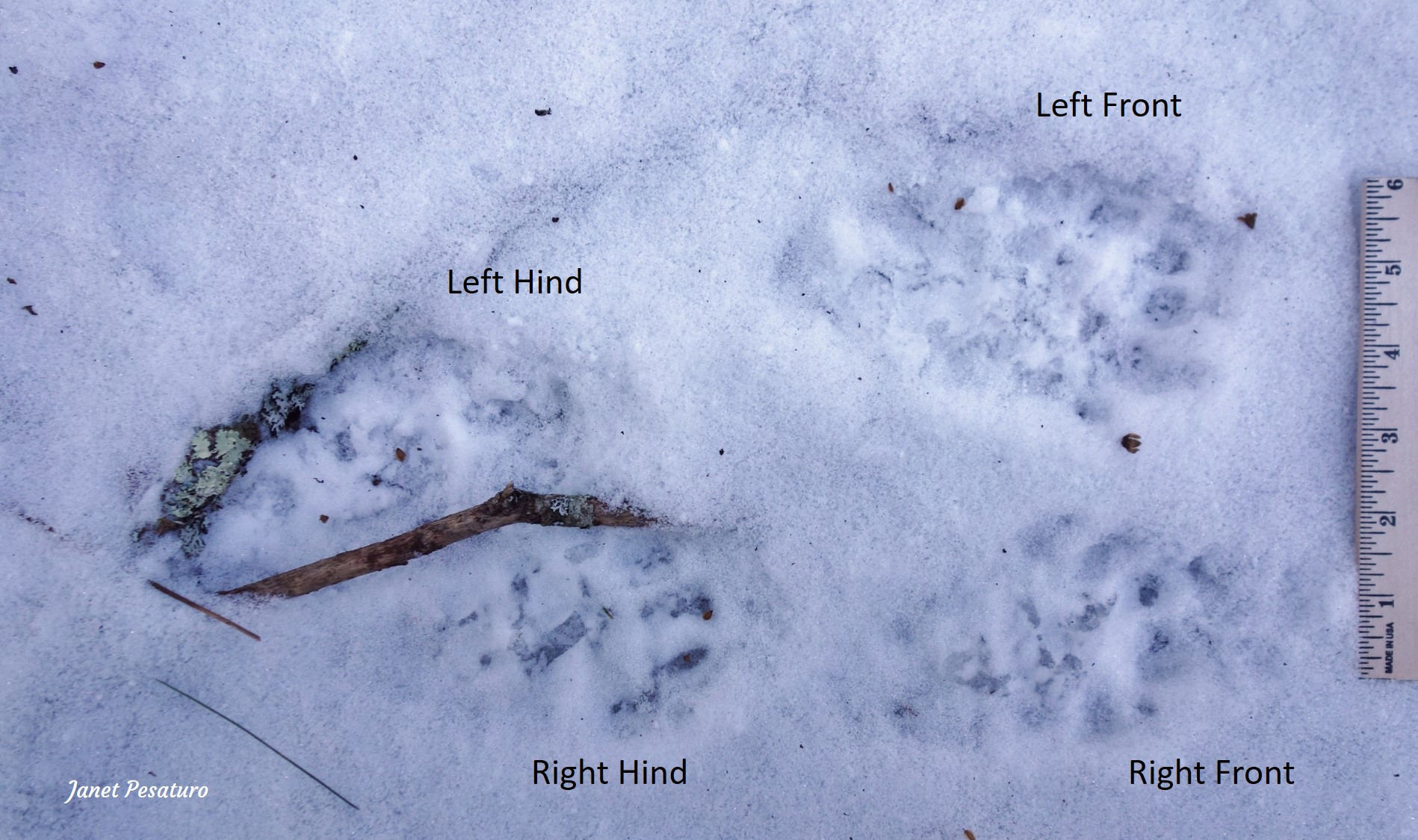 Fisher tracks in a stop pattern, made by a fisher standing still on all four feet in the snow. The toes are clearer due to the moister and stickier snow.
Fisher tracks in a stop pattern, made by a fisher standing still on all four feet in the snow. The toes are clearer due to the moister and stickier snow.
Tracks left by a fisher in a stop pattern, indicating it was standing still. The clearer toe definition is due to the moister, stickier snow.
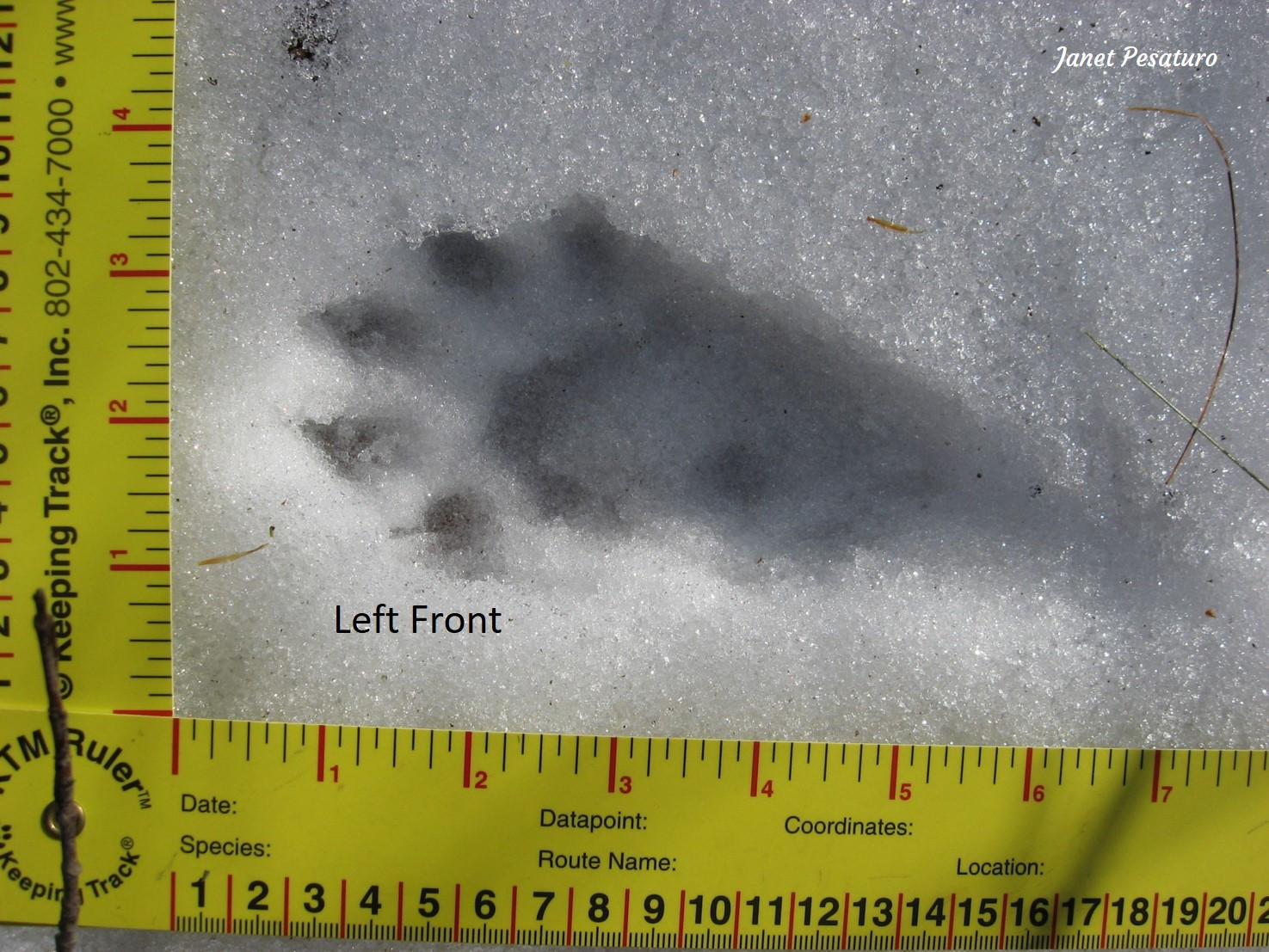 Left front fisher track clearly showing toes, metacarpal, and carpal pads in moist snow with a thin crust.
Left front fisher track clearly showing toes, metacarpal, and carpal pads in moist snow with a thin crust.
A clear left front fisher track in moist snow with a thin crust, showing distinct toes, metacarpal, and carpal pads. The crust gives a false impression of webbing.
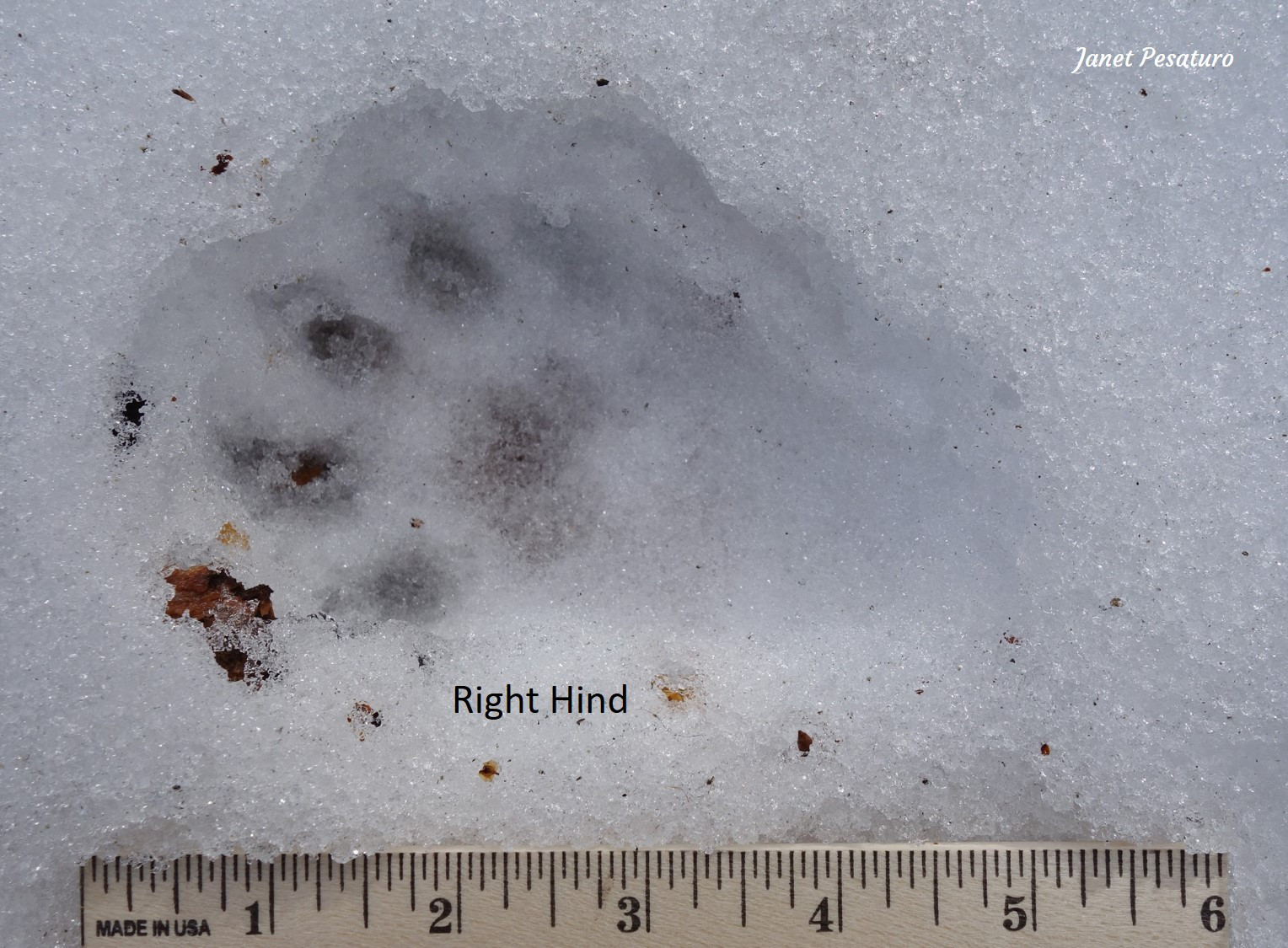 Right hind fisher track showing toe tips and metacarpal pad in snow with a thin crust. The heel does not register as a discrete pad due to fur.
Right hind fisher track showing toe tips and metacarpal pad in snow with a thin crust. The heel does not register as a discrete pad due to fur.
A right hind fisher track in snow with a thin crust. Note the faint connection between toe tips and metacarpal pad and the lack of a distinct heel pad due to fur.
Fisher Trail Patterns
Fishers move in a variety of gaits, including walks, trots, lopes, and gallops. In snow tracking, the lope pattern is most commonly observed. In deeper snow, fishers often employ a 2×2 lope, where the hind foot lands in or near the print of the front foot, conserving energy in the snow. In shallower snow, they might use a 3×4 rotary lope, where the hind track superimposes the front track on the same side of the body. They also utilize a transverse lope. Distinguishing these patterns can tell you more about the animal’s movement and the snow conditions.
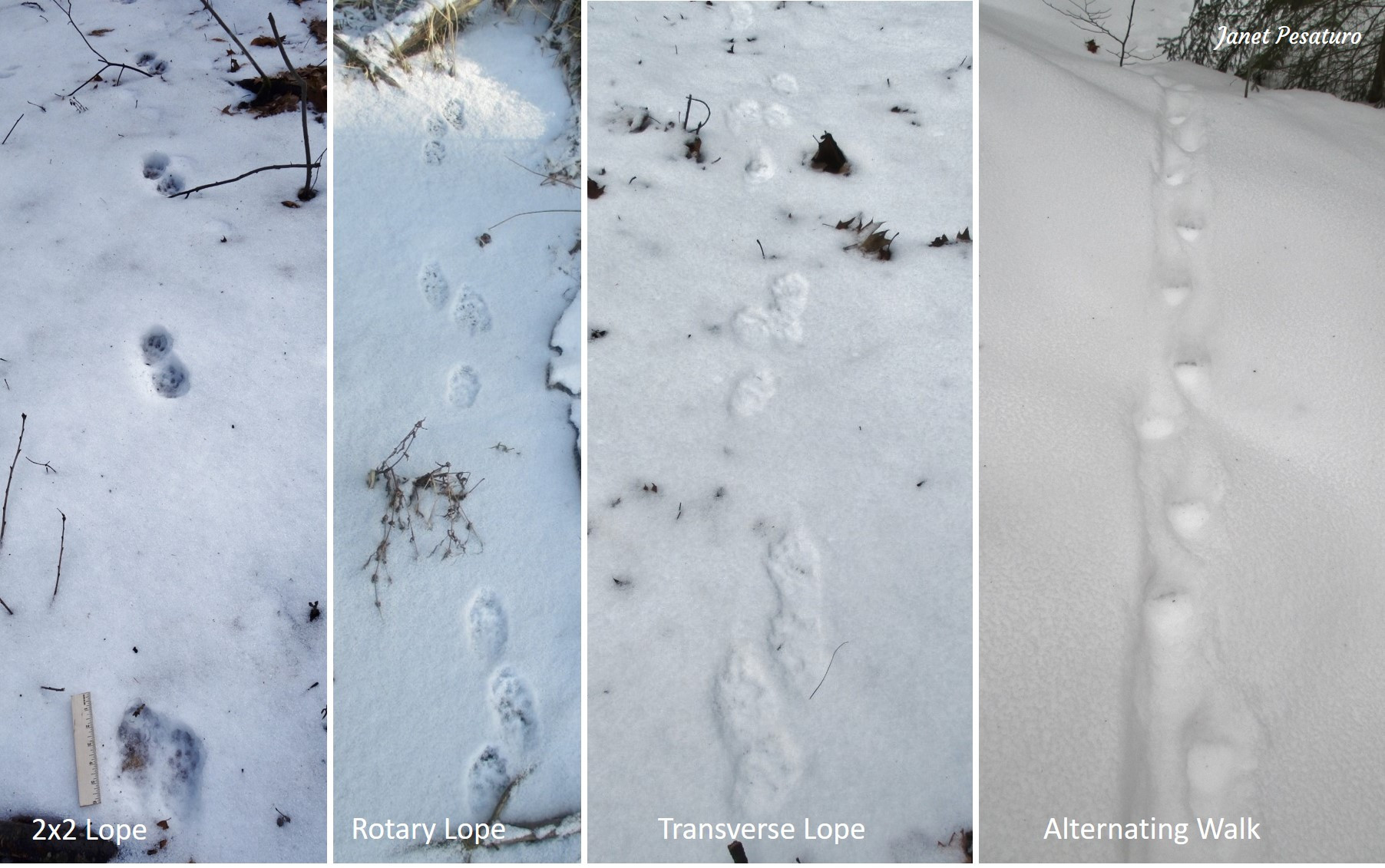 Four common fisher track patterns in snow: 2×2 lope, rotary lope, transverse lope, and alternating walk.
Four common fisher track patterns in snow: 2×2 lope, rotary lope, transverse lope, and alternating walk.
Four distinct fisher track patterns: 2×2 lope, rotary lope, transverse lope, and alternating walk, illustrating different movement styles.
Body Prints in Snow
Occasionally, you might encounter a fisher body print in deep snow, often left when they jump down from trees. This is a rarer find, especially in areas with less snowfall. More commonly, you’ll see just the four-foot impressions where a fisher landed after a jump. Body prints offer a unique and exciting glimpse into the fisher’s presence.
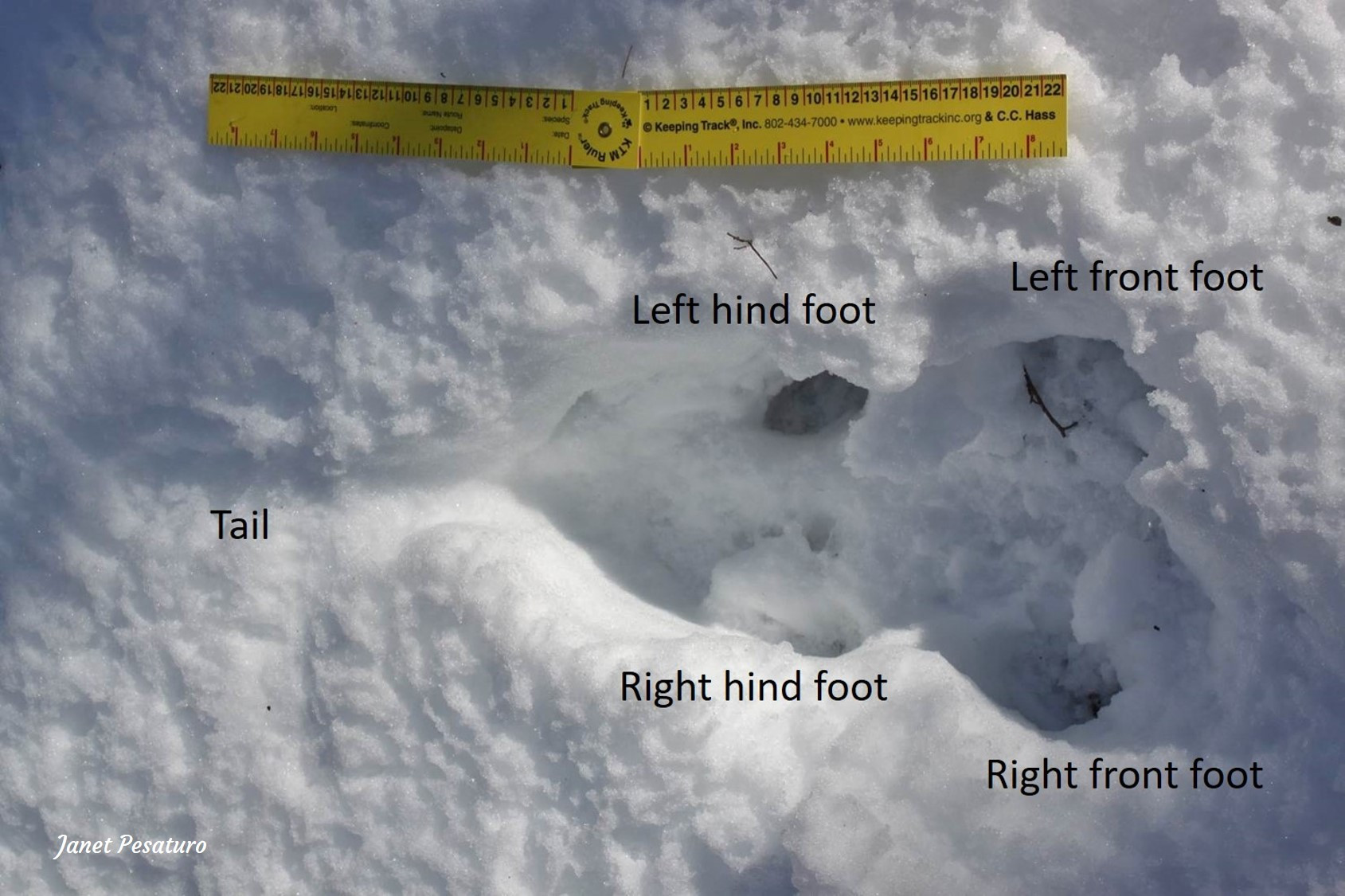 A clear fisher body print in deep snow, showing the impression of the entire animal.
A clear fisher body print in deep snow, showing the impression of the entire animal.
A remarkably clear fisher body print in the snow, providing a full outline of the animal’s form.
Winter Dens in Snow
Fisher breeding dens are typically found in tree cavities, but winter shelters are often different. In winter, fishers may use tree cavities but are more likely to seek shelter at ground level. These winter “dens” can be in hollow logs, under rocks or roots, or within brush piles. In deep snow, these ground-level dens become easier to spot. They often consist of tunnels leading to a chamber under the snow (subnivean) or to a sheltered spot at ground level. Fishers often leave scat near the entrance of these winter dens, providing another clue to their presence.
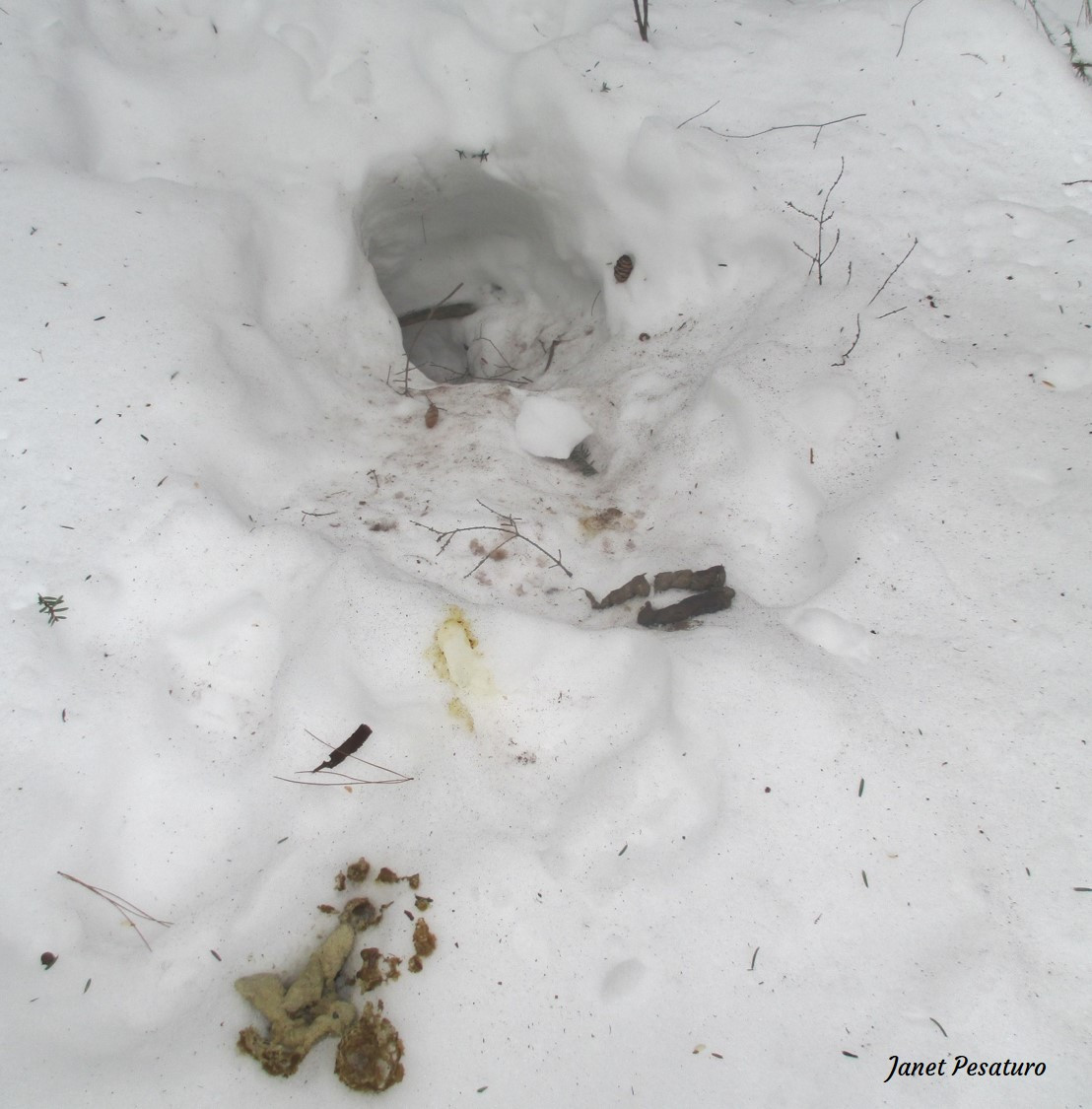 A fisher snow den entrance with scat and urine markings visible near the hole.
A fisher snow den entrance with scat and urine markings visible near the hole.
A fisher “snow den” entrance, indicated by scat and urine markings near the opening, a sign of winter habitation.
Fisher Scat Identification
Fisher scat can sometimes be confused with fox scat, especially since fishers, like foxes, may deposit scat on elevated surfaces like stumps and logs. To differentiate, look for associated tracks. Fisher scat is generally less than 1/2 inch in diameter and can be quite thin. Sometimes they produce very small scats that resemble those of smaller weasels. A key characteristic of fisher scat is its often twisted, tapered shape with pointed ends, sometimes described as “extremely twisted, tapered ropes with pointed ends” when filled with hair. While many fisher scats are tapered, the twisted appearance can vary.
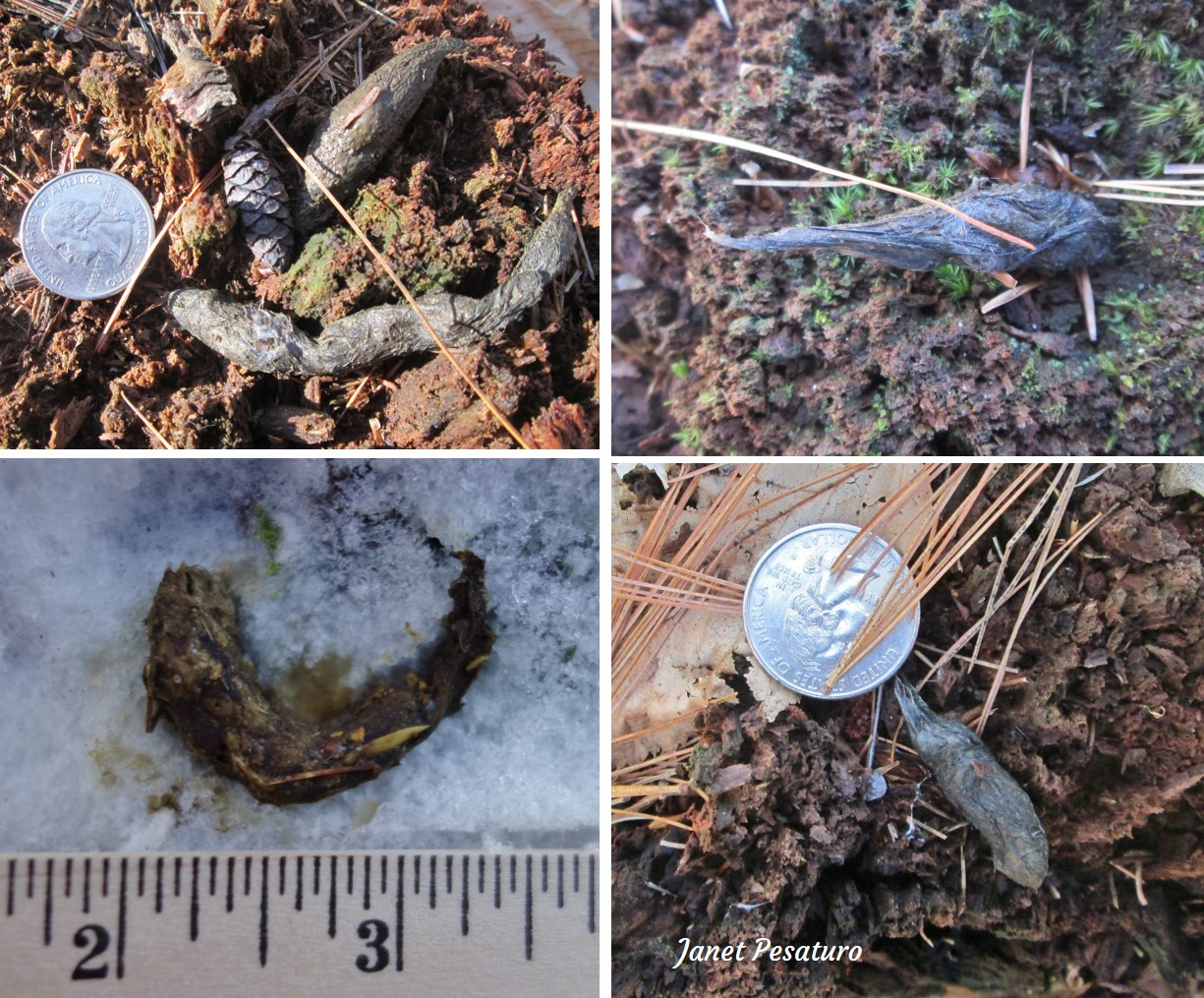 Examples of fisher scats found on stumps in the forest.
Examples of fisher scats found on stumps in the forest.
Examples of fisher scats found on stumps, demonstrating variations in shape and size.
Slides and Belly Drags
Unlike river otters, fishers are not frequent sliders. When they do slide, it’s usually for short distances, just a few feet. These short slides are often interpreted as scent marking, more accurately termed “body drags.” While some believe fishers occasionally slide for fun or efficient travel, with observed slides up to 10 feet long, personal observations suggest otherwise. Short belly drags, possibly for scent marking, are more typical.
Scent Marking Behavior Beyond Scat
Besides scat and belly dragging, fishers use urine and anal gland secretions for scent marking. They also roll around and may “maul” conifer saplings as scent marking behavior. Fisher urine has a distinctive odor, sometimes likened to American marten urine, but it lacks the skunky smell of fox urine or the scent of cat or coyote urine. Anal gland secretions, if visible in snow, might appear as small circles of mucus. Fur is another common scent marking sign, often found on the ground or caught on vegetation where a fisher has rolled. The “mauling” of conifer saplings is less frequently observed; fishers seem to roll and leave fur on whatever vegetation is available.
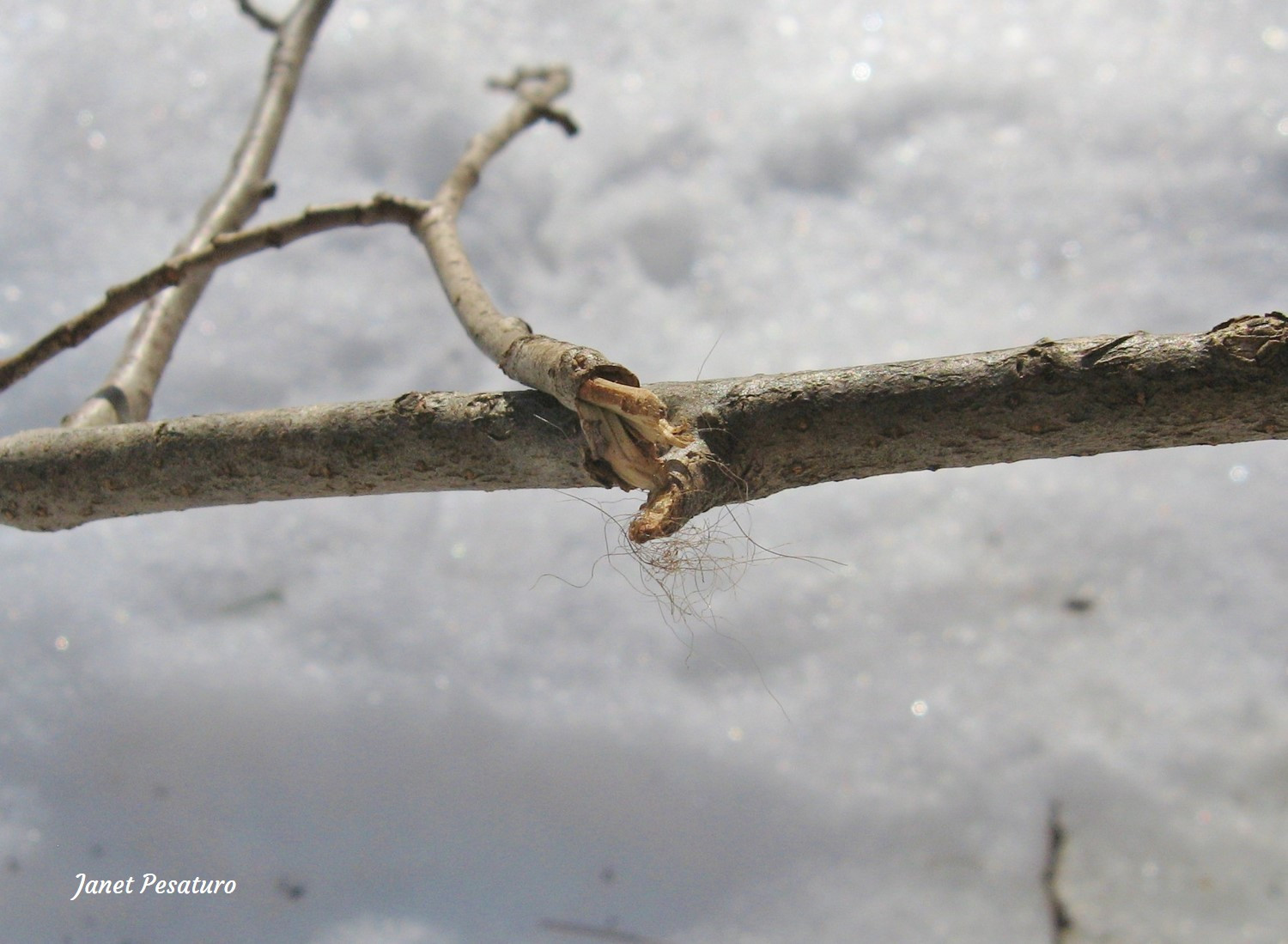 Fisher fur caught on a broken branch, indicating a rolling or scent-marking spot.
Fisher fur caught on a broken branch, indicating a rolling or scent-marking spot.
Fisher fur snagged on a broken branch, evidence of rolling and scent marking activity in the area.
Tracking animals in snow, whether you’re following “cat tracks snow” or the trail of a fisher, offers a unique way to connect with the winter wilderness. By learning to identify tracks and signs, you can unlock the hidden stories written in the snow and gain a deeper appreciation for the wildlife that shares our world. So, venture out into the snowy woods, sharpen your observation skills, and see what winter tales the tracks reveal!
Sources
- Elbroch, M. and C. McFarland. Mammals Tracks & Sign: A Guide to North American Mammals. 2nd Edition. Guilford, CT: Stackpole Books, 2019.
- Powell, R. A. The Fisher: Life History, Ecology, and Behavior. Minneapolis, MN: University of Minnesota Press, 1993.

